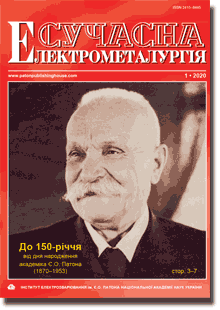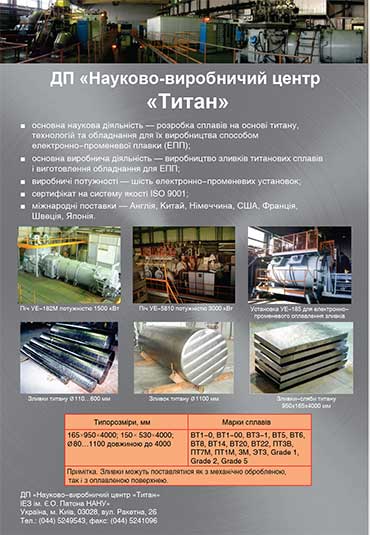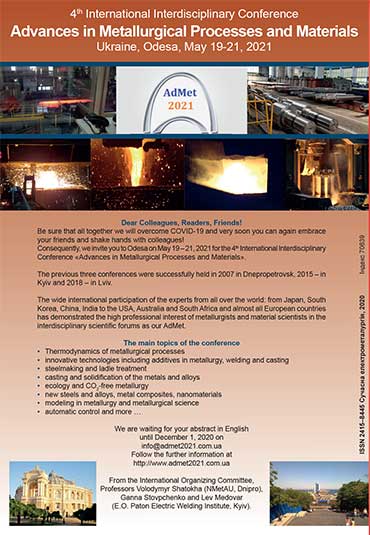| 2020 №01 (03) |
DOI of Article 10.37434/sem2020.01.04 |
2020 №01 (05) |

"Suchasna Elektrometallurgiya" (Electrometallurgy Today), 2020, #1, 32-38 pages
Corrosion and erosion resistance of copper and molybdenum composite materials condensed from the vapour phase
I.M. Grechanyuk1, V.G. Grechanyuk2
1SPC «ELTECHMASH». 25 Vatutina Str., 21011, Vynnitsa, Ukraine. E-Mail: vin25ebt@ukr.net
2Kyiv National University of Construction and Architecture. 31 Povitroflosky Ave., 03037, Kyiv, Ukraine. E-Mail: knuba@knuba.edu.ua
Abstract
The corrosion and erosion resistance of copper and molybdenum-based composite materials used as contact materials are considered in the paper. It is found that zirconium and yttrium (material MDK-3: Cu–(10…12 %) Mo–(0.2 %) Zr, Y) when introduced into the Cu–Mo system, increase the corrosion resistance by 20 % and the deep corrosion index decreases to 0.02 g/(m2·year). It is shown that the dependence of contact temperature change on the contact resistance is linear, the higher the contact resistance, the more intensively the contact temperature increases. The dependence of contact resistance of contacts made of materials MDK-3 and Ag–CdO on the number of switching cycles is established. The characteristics of contacts made of silver-containing materials and contact materials from MDK-3 were compared, and the advantages of the latter were shown. Ref. 9, Tabl. 1, Fig. 8.
Keywords: composite materials; corrosion resistance; contact resistance; contact materials, dispersion-strengthened materials
Received 14.12.2019
References
1. Grechanyuk, V.G. (2013) Physical-chemical principles of formation of copper-based composite materials condensed from vapor phase: Syn. of Thesis for Dr. Chem. Sci. Degree. Kyiv, 40 [in Ukrainian].2. Grechanyuk, N.I., Minakova, R.V., Vasilega, O.P. et al. (2010) State-of-the art and prospects of application of high-velocity electron beam evaporation technology and subsequent vacuum condensation of metals and nonmetals for producing of electric contact and electrodes. In: Collect. of IPS NASU: Electric contacts and electrodes. Kiev, 54−57 [in Russian].
3. Grechanyuk, N.I., Grechanyuk, V.G. (2018) Dispersed and laminar volumetric nanocrystal materials on base of copper and molybdenum. Structure, properties, technology, application. Information 1. Structure and phase composition. Sovrem. Elektrometall., 1, 42−53 [in Russian]. https://doi.org/10.15407/sem2018.01.06
4. Grechanyuk, N.I., Grechanyuk, V.G. (2019) Mechanical properties of dispersed and laminar composite materials on copper and molybdenum base. Ibid., 2, 43−49 [in Russian]. https://doi.org/10.15407/sem2019.02.07
5. (1980) Unified procedures of laboratory testing of effectiveness of corrosion inhibitors in aqueous systems. Riga, Inst. of Inorganic Chemistry [in Russian].
6. Grechanyuk, I.N., Grechanyuk, V.G., Emelyanov, B.M., Rudenko, I.F. (1998) Corrosion of composite materials on copper base applied for electric contacts. In: Collect. of IPS NASU: Electric contacts and electrodes. Kiev, 140−144 [in Russian].
7. TU U 20113410.001−98: Dispersion-strengthened materials for electric contacts [in Russian].
8. TU U 24.4-53966101.2014: Dispersion-strengthened materials for electric contacts [in Ukrainian].
9. TU U 31.2-20113410-003−2002: Electric contacts based on dispersion-strengthened materials (MDK) [in Russian].


